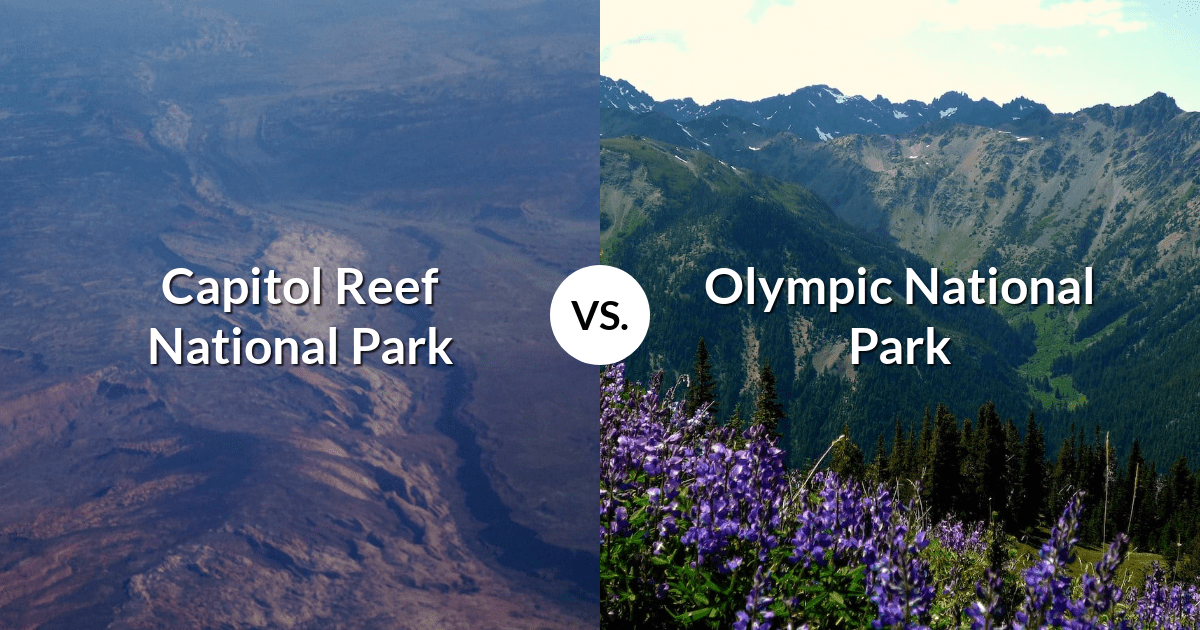Jake Cain is an entrepreneur and writer from Cincinnati, Ohio. He spends his free time driving around the country in his late 90’s conversion van, affectionately known as the “Monster Van” with his wife and 3 boys.
Capitol Reef National Park and Olympic National Park are two of America’s most diverse and breathtaking national parks. One is a desert oasis in the heart of Utah, while the other is a lush rainforest on the Olympic Peninsula in Washington state. Both parks offer unique landscapes and experiences that are sure to leave visitors in awe. Whether you’re a fan of red rock formations, crystal-clear rivers, or towering peaks, these two parks have something for everyone. So, grab your hiking boots and pack your camera, because we’re about to embark on a journey through two of the most incredible national parks in the country!
Hiking Trails in Capitol Reef National Park and Olympic National Park
Capitol Reef National Park and Olympic National Park are both known for their stunning natural beauty and offer a variety of hiking trails for visitors to explore. Here’s a comparison of the hiking trails at each park:
Capitol Reef National Park:
– Easy Hikes: Some of the easiest hikes in the park include the Capitol Gorge Trail, the Rim Overlook Trail, and the Grand Wash Trail. These trails offer a great introduction to the park’s natural beauty and are suitable for families with children and visitors of all ages.
– Challenging Hikes: For more experienced hikers, the park offers a number of challenging trails, including the Cassidy Arch Trail, the Fremont River Trail, and the Navajo Knobs Trail. These trails offer stunning views of the park’s rugged landscape and are suitable for experienced hikers looking for a challenge.
Olympic National Park:
– Easy Hikes: Some of the easiest hikes in the park include the Hoh Rainforest Trail, the Hurricane Ridge Trail, and the Sol Duc Falls Trail. These trails offer a great introduction to the park’s natural beauty and are suitable for families with children and visitors of all ages.
– Challenging Hikes: For more experienced hikers, the park offers a number of challenging trails, including the Mount Olympus Trail, the Seven Lakes Basin Trail, and the High Divide Trail. These trails offer stunning views of the park’s rugged landscape and are suitable for experienced hikers looking for a challenge.
In conclusion, both Capitol Reef National Park and Olympic National Park offer a variety of hiking trails for visitors of all abilities, from easy nature walks to challenging backcountry hikes. Whether you’re a beginner or an experienced hiker, these two parks offer a wealth of opportunities for adventure and discovery on the trails.
Most Popular Hiking Trails in Capitol Reef National Park
| Name | Length | Elevation | Type | Difficulty | Visitor Ratings |
|---|---|---|---|---|---|
| Hickman Bridge Trail | 2735.878 | 129.8448 | Moderate | out and back | 4.5 |
| Cassidy Arch Trail | 4667.086 | 213.9696 | Moderate | out and back | 4.5 |
| Grand Wash Trail via Northeast Trailhead | 7081.096 | 121.92 | Easy | out and back | 4.5 |
| Chimney Rock Loop Trail | 5310.822 | 241.7064 | Moderate | loop | 4.5 |
| Cohab Canyon Trail | 4828.02 | 241.7064 | Moderate | out and back | 4.5 |
| Navajo Knobs Trail | 14001.258 | 650.748 | Hard | out and back | 4.5 |
| Goosenecks & Sunset Point | 4023.35 | 165.8112 | Easy | out and back | 4.5 |
| Capitol Gorge Trail | 7242.03 | 113.9952 | Moderate | out and back | 4 |
| Sulphur Creek Route | 18507.41 | 427.9392 | Easy | out and back | 4.5 |
| Rim Overlook Trail | 6598.294 | 320.9544 | Hard | out and back | 4.5 |
Most Popular Hiking Trails in Olympic National Park
| Name | Length | Elevation | Type | Difficulty | Visitor Ratings |
|---|---|---|---|---|---|
| Hurricane Hill via Hurricane Ridge | 4988.954 | 242.9256 | Moderate | out and back | 4.5 |
| Mount Storm King | 6276.426 | 638.8608 | Hard | out and back | 5 |
| Sol Duc Falls Nature Trail | 2574.944 | 77.724 | Easy | out and back | 4.5 |
| Hoh Rain Forest Hall of Moss | 1609.34 | 23.7744 | Easy | loop | 4.5 |
| Marymere Falls Trail | 2735.878 | 90.8304 | Easy | out and back | 4.5 |
| Hoh River Trail | 52786.352 | 1558.7472 | Moderate | out and back | 4.5 |
| High Divide – Seven Lakes Basin Loop | 30577.46 | 1617.8784 | Hard | loop | 5 |
| Ruby Beach | 2253.076 | 20.7264 | Easy | loop | 4.5 |
| Staircase Rapids Loop | 3379.614 | 64.9224 | Easy | loop | 4.5 |
| Spruce Railroad Trail: Lake Crescent | 18024.608 | 131.9784 | Easy | out and back | 4.5 |
Wildlife in Capitol Reef National Park and Olympic National Park
Capitol Reef National Park and Olympic National Park are both rich in wildlife, offering visitors a chance to see a variety of animals, birds, and plants in their natural habitats. However, each park has its own unique set of wildlife, and the type of wildlife you will see will depend on the time of year, the location within the park, and the specific habitats you visit.
At Capitol Reef National Park, visitors can expect to see a variety of wildlife, including mule deer, bighorn sheep, and pronghorns, as well as a variety of bird species, such as the rock wren, the peregrine falcon, and the golden eagle. The park is also home to a number of reptiles, including lizards and snakes, as well as a variety of mammals, such as the black-tailed jackrabbit and the kit fox. In addition to its wildlife, the park is also home to a number of unique and diverse plant species, including cacti, wildflowers, and sagebrush.
At Olympic National Park, visitors can expect to see a variety of wildlife, including black bears, elk, and mountain goats, as well as a variety of bird species, such as the bald eagle, the spotted owl, and the marbled murrelet. The park is also home to a number of marine mammals, including sea otters and harbor seals, as well as a variety of fish species, such as salmon and steelhead. In addition to its wildlife, the park is also home to a number of unique and diverse plant species, including old-growth forests, alpine meadows, and temperate rainforests.
In conclusion, both Capitol Reef National Park and Olympic National Park offer a variety of wildlife, birds, and plants for visitors to see and enjoy. The specific wildlife you will see will depend on the time of year, the location within the park, and the specific habitats you visit.
Below are lists of the most commonly spotted wildlife at Capitol Reef National Park and Olympic National Park. However, you can see a full list of wildlife at each national park here.
Birds
| Capitol Reef National Park | Olympic National Park |
|---|---|
| Peregrine Falcon | Peregrine Falcon |
| Northern Harrier | Northern Harrier |
| Sharp-Shinned Hawk | Sharp-Shinned Hawk |
| Osprey | Osprey |
| Tree Swallow | Tree Swallow |
| Mallard | Mallard |
| Canada Goose | Canada Goose |
| Lincoln’s Sparrow | Lincoln’s Sparrow |
| Ruby-Crowned Kinglet | Ruby-Crowned Kinglet |
| American Robin | American Robin |
| Great Horned Owl | Great Horned Owl |
| Red-Tailed Hawk | Red-Tailed Hawk |
| Northern Flicker | Northern Flicker |
| Merlin | Barn Swallow |
| Barn Swallow | Savannah Sparrow |
| Savannah Sparrow | Great Blue Heron |
| Great Blue Heron | Hermit Thrush |
| Hermit Thrush | American Kestrel |
| American Kestrel | Bald Eagle |
| Bald Eagle | Song Sparrow |
| Song Sparrow | European Starling |
| European Starling | Northern Pintail |
| Northern Pintail | American Wigeon |
| American Wigeon | Green-Winged Teal |
| Green-Winged Teal | American Pipit |
Mammals
| Capitol Reef National Park | Olympic National Park |
|---|---|
| Coyote | Coyote |
| American Beaver | American Beaver |
| Muskrat | Muskrat |
| Big Brown Bat | Big Brown Bat |
| Bobcat | Striped Skunk |
| Striped Skunk | Little Brown Bat |
| Little Brown Bat | Deer Mouse |
| Deer Mouse | Raccoon |
| Raccoon | Black Bear |
| Black Bear | Porcupine |
| Porcupine | Silver-Haired Bat |
| Silver-Haired Bat | Red Fox |
| Hoary Bat | Long-Tailed Weasel |
| Red Fox | House Mouse |
| Long-Tailed Weasel | Wolf |
| House Mouse | Long-Legged Myotis |
| Mountain Lion | Long-Eared Myotis |
| American Mink | California Myotis |
| Mule Deer | Snowshoe Rabbit |
| Common Gray Fox | North American River Otter |
| Long-Legged Myotis | Fringe-Tailed Myotis |
| Long-Eared Myotis | Masked Shrew |
| American Badger | Water Shrew |
| Ermine | Western Big-Eared Bat |
| California Myotis | Bushy-Tailed Woodrat |
Fish
| Capitol Reef National Park | Olympic National Park |
|---|---|
| Rainbow Trout | Steelhead/Rainbow Trout |
| Brown Trout | Brook Trout |
| Bluegill | Largemouth Bass |
| Mottled Sculpin | Salish Sucker |
| Speckled Dace | Coho Salmon |
| Black Bullhead | Chinook Salmon |
| Cutthroat Trout | Longnose Dace |
| Speckled Dace | |
| Threespine Stickleback | |
| Sockeye Salmon | |
| Pink Salmon | |
| Chum Salmon | |
| Dolly Varden | |
| Cutthroat Trout |
Reptiles
| Capitol Reef National Park | Olympic National Park |
|---|---|
| Gophersnake | Western Terrestrial Garter Snake |
| Terrestrial Gartersnake | Common Garter Snake |
| Prairie Rattlesnake | Rubber Boa |
| Common Sagebrush Lizard | Western Fence Lizard |
| Greater Short-Horned Lizard | |
| Side-Blotched Lizard | |
| Common Kingsnake | |
| Nightsnake | |
| Long-Nosed Leopard Lizard | |
| Striped Whipsnake | |
| Smith’s Black-Headed Snake | |
| Tree Lizard | |
| Western Whiptail | |
| Western Skink | |
| Desert Spiny Lizard |
Amphibians
| Capitol Reef National Park | Olympic National Park |
|---|---|
| Northern Leopard Frog | Bullfrog |
| Tiger Salamander | |
| Woodhouse’s Toad | |
| Red-Spotted Toad | |
| Canyon Treefrog |
Insects
| Capitol Reef National Park | Olympic National Park |
|---|---|
| Honey Bee |
Beautiful Landscapes in Capitol Reef National Park and Olympic National Park
Capitol Reef National Park is home to some of the most iconic and beautiful landscapes in the American Southwest. The park’s most famous landmark is the Waterpocket Fold, a 100-mile long wrinkle in the Earth’s crust that offers stunning panoramic views of the surrounding desert landscape. Visitors can also explore the park’s many slot canyons, including the popular Cathedral Valley and Halls Creek Canyon, which offer unique and awe-inspiring experiences.
Olympic National Park, on the other hand, is known for its diverse landscapes that range from towering peaks to lush rainforests. The park’s most famous landscape is the Olympic Mountains, which offer breathtaking views of the surrounding Pacific coastline. Visitors can also explore the park’s many waterfalls, including the Sol Duc Falls and Marymere Falls, which are popular destinations for hikers and nature enthusiasts. The park is also home to the Hoh Rainforest, one of the largest temperate rainforests in the world, which offers a unique and immersive experience for visitors.
In conclusion, both Capitol Reef National Park and Olympic National Park offer a wealth of beautiful landscapes and natural wonders that are sure to leave visitors in awe. Whether you’re a fan of towering peaks, stunning waterfalls, or lush rainforests, these two parks have something for everyone.
Things To-Do and Activities in Capitol Reef National Park and Olympic National Park
Capitol Reef National Park and Olympic National Park offer a variety of popular activities for visitors to enjoy. Capitol Reef is a popular destination for hiking, rock climbing, and scenic drives. The park’s many trails offer opportunities for visitors to explore the Waterpocket Fold, slot canyons, and other unique geological formations. The park is also a popular destination for bird watching and wildlife viewing, with a variety of species including desert bighorn sheep, pronghorns, and rattlesnakes.
Olympic National Park is a popular destination for hiking, camping, and wildlife viewing. The park’s many trails offer opportunities for visitors to explore the Olympic Mountains, the Hoh Rainforest, and the Pacific coastline. The park is also a popular destination for kayaking, fishing, and beachcombing, with a variety of species including bald eagles, river otters, and gray whales.
In conclusion, both Capitol Reef National Park and Olympic National Park offer a range of popular activities for visitors to enjoy. Whether you’re a fan of hiking, camping, or wildlife viewing, these two parks have something for everyone. So, pack your gear and get ready for an unforgettable outdoor adventure!
Best Time to Visit Capitol Reef National Park and Olympic National Park
Capitol Reef National Park and Olympic National Park have different seasonal weather patterns that can greatly impact the best time to visit each park.
Capitol Reef National Park is located in a semi-arid desert climate with hot summers and cool winters. The park is at its most pleasant from spring to fall, with temperatures ranging from the mid-60s to mid-80s. Summer is the peak tourist season, but it can also be very hot, with temperatures often reaching 100°F. Winter can bring snow and cold temperatures, making it a less popular time to visit.
Olympic National Park, on the other hand, is located in a temperate rainforest and experiences a maritime climate, with mild, wet winters and cool, dry summers. The park is at its most pleasant from late spring to early autumn, with temperatures ranging from the mid-50s to mid-70s. Summer is the driest time to visit, but it can also be quite cool. Winter is the wettest time, with heavy rain and snow at higher elevations, making it a less popular time to visit.
In conclusion, the best time to visit Capitol Reef National Park is from spring to fall, while the best time to visit Olympic National Park is from late spring to early autumn. The weather conditions at each park greatly affect the type of activities that are possible and the overall experience of a visit, so it’s important to consider the seasonal weather when planning a trip.
Family Friendliness of Capitol Reef National Park and Olympic National Park
Capitol Reef National Park and Olympic National Park are both family-friendly and offer a variety of activities for visitors of all ages. However, the best park to visit with children will depend on the interests and abilities of the family.
At Capitol Reef, families can enjoy scenic drives, short hikes to unique geological formations, and ranger-led programs. The park also has picnic areas and a visitor center with educational exhibits.
At Olympic National Park, families can explore the diverse landscapes, from the Pacific coastline to the temperate rainforest to the alpine meadows. There are also many kid-friendly hikes, including easy walks to waterfalls and beachcombing along the coast. The park also has ranger-led programs and family-friendly camping options.
Ultimately, both parks offer a great opportunity for families to connect with nature and learn about the unique ecosystems. The best park to visit will depend on the family’s specific interests and the time of year they are visiting.


